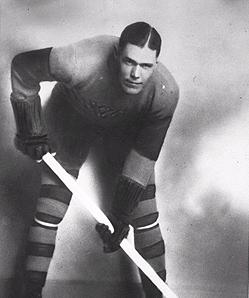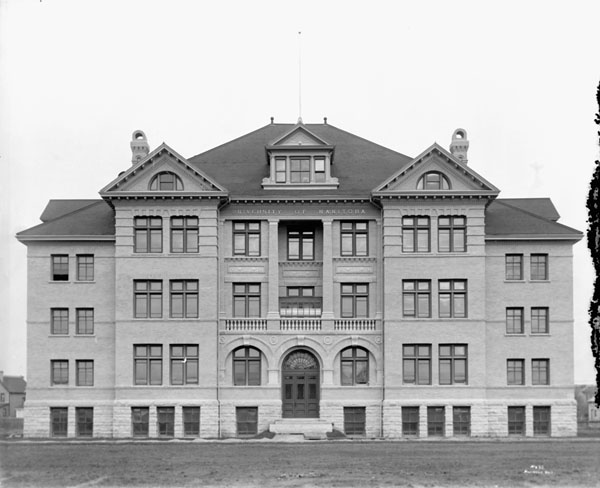|
Frank Frederickson
Sigurdur Franklin Fredrickson (Sigurður Franklín Friðriksson; June 3, 1895 – May 28, 1979) was an Icelandic-Canadian ice hockey player and aviator. As a player and coach, he was significant to both the amateur and professional ice hockey as it evolved in North America in the early 20th century. Fredrickson's career was interrupted by military service during the First World War and prematurely ended by a knee injury in 1931. Fredrickson was the center for the Winnipeg Falcons, the Canadian team which won the Olympic gold medal in 1920. Fredrickson then joined the Victoria Aristocrats/Victoria Cougars and helped them win the Stanley Cup in 1925. On both occasions he was a teammate of fellow Icelandic-Canadian ice hockey star Haldor Halderson, making them the first players to win an Olympic gold medal and a Stanley Cup. Fredrickson became one of the pioneers of flight in Iceland when he arrived there in 1920 to fly for the country's first airline, ''Flugfélag Íslands''. T ... [...More Info...] [...Related Items...] OR: [Wikipedia] [Google] [Baidu] |
Ice Hockey At The 1920 Summer Olympics
Ice hockey was introduced to the Olympic Games at the 1920 Summer Olympics in Antwerp. The tournament also served as the first World Championships. The matches were played between April 23 and April 29, 1920. Canada, represented by the Winnipeg Falcons, won the gold medal. The silver went to the United States and Czechoslovakia took the bronze. Summary The organizing committee for the hockey matches included Paul Loicq, the captain of the Belgian team and a future president of the Ligue Internationale de Hockey sur Glace (LIHG). The games used the Canadian ice hockey rules, and the Bergvall system to determine medal winning teams. The Canadian Amateur Hockey Association (CAHA) chose the Winnipeg Falcons as the 1920 Allan Cup champions to represent the Canada men's national team, instead of forming a national all-star team on short notice.Podnieks, Andrew; Hockey Hall of Fame (2005), pp. 28–29 Canada's manager W. A. Hewitt, introduced the CAHA rules of play to the LIHG ... [...More Info...] [...Related Items...] OR: [Wikipedia] [Google] [Baidu] |
North America
North America is a continent in the Northern Hemisphere, Northern and Western Hemisphere, Western hemispheres. North America is bordered to the north by the Arctic Ocean, to the east by the Atlantic Ocean, to the southeast by South America and the Caribbean Sea, and to the south and west by the Pacific Ocean. The region includes Middle America (Americas), Middle America (comprising the Caribbean, Central America, and Mexico) and Northern America. North America covers an area of about , representing approximately 16.5% of Earth's land area and 4.8% of its total surface area. It is the third-largest continent by size after Asia and Africa, and the list of continents and continental subregions by population, fourth-largest continent by population after Asia, Africa, and Europe. , North America's population was estimated as over 592 million people in list of sovereign states and dependent territories in North America, 23 independent states, or about 7.5% of the world's popula ... [...More Info...] [...Related Items...] OR: [Wikipedia] [Google] [Baidu] |
Royal Flying Corps
The Royal Flying Corps (RFC) was the air arm of the British Army before and during the First World War until it merged with the Royal Naval Air Service on 1 April 1918 to form the Royal Air Force. During the early part of the war, the RFC supported the British Army by artillery co-operation and photographic reconnaissance. This work gradually led RFC pilots into aerial battles with German pilots and later in the war included the strafing of enemy infantry and emplacements, the bombing of German military airfields and later the strategic bombing of German industrial and transport facilities. At the start of World War I the RFC, commanded by Brigadier-General Sir David Henderson, consisted of five squadrons – one observation balloon squadron (RFC No 1 Squadron) and four aeroplane squadrons. These were first used for aerial spotting on 13 September 1914 but only became efficient when they perfected the use of wireless communication at Aubers Ridge on 9 May 1915. Ae ... [...More Info...] [...Related Items...] OR: [Wikipedia] [Google] [Baidu] |
223rd Battalion (Canadian Scandinavians), CEF
The 223rd (Scandinavians) Battalion, CEF was a unit in the Canadian Expeditionary Force during the First World War. Based in Winnipeg, Manitoba, the unit began recruiting in early 1916 in Military Districts 10, 11, 12, and 13. After sailing to England in May 1917, the battalion was absorbed into the 11th Reserve Battalion on May 14, 1917. The 223rd (Scandinavians) Battalion, CEF had one Officer Commanding: Lieut-Col. H. M. Hannesson. The battalion also had the Bohemian detachment consisting of volunteers from among Czech emigrants to Canada and the United States, who were also allowed to carry their own Flag of Bohemia, red and white flag. See also *197th Battalion (Vikings of Canada), CEF References Battalions of the Canadian Expeditionary Force Military units and formations of Manitoba {{Manitoba-stub ... [...More Info...] [...Related Items...] OR: [Wikipedia] [Google] [Baidu] |
196th Battalion (Western Universities), CEF
The 196th (Western Universities) Battalion, CEF was a List of infantry battalions in the Canadian Expeditionary Force, numbered battalion in the Canadian Expeditionary Force during the First World War. Based in Winnipeg, Manitoba, the unit began recruiting during the winter of 1915/16 in universities throughout western Canada. After sailing to England in November 1916, the battalion was absorbed into the 19th Reserve Battalion on January 2, 1917, and its members were later dispersed across a number of different units. History Creation During the First World War, university staff and students from across western Canada wanted the opportunity to serve in the military while retaining their collective university identities. In December 1915, the University of Manitoba branch of the Canadian Officers' Training Corps sent two representatives to the University of British Columbia, University of Alberta, and University of Saskatchewan to lobby for these schools to agree on forming s ... [...More Info...] [...Related Items...] OR: [Wikipedia] [Google] [Baidu] |
University Of Manitoba
The University of Manitoba (U of M, UManitoba, or UM) is a public research university in Winnipeg, Manitoba, Canada. Founded in 1877, it is the first university of Western Canada. Both by total student enrolment and campus area, the University of Manitoba is the largest university in the province of Manitoba. Its main campus is located in the Fort Garry, Winnipeg, Fort Garry neighbourhood of Winnipeg, with other campuses throughout the city: the Bannatyne Campus, the James W. Burns Executive Education Centre, the William Norrie Centre, and the French-language affiliate, Université de Saint-Boniface in the Saint Boniface, Winnipeg, Saint Boniface ward. Research at the university contributed to the creation of canola oil in the 1970s. Likewise, University of Manitoba alumni include Nobel Prize recipients, Academy Awards, Academy Award winners, Order of Merit recipients, and Lists of Olympic medalists, Olympic medalists. , there have been 99 Rhodes Scholarship recipients from the Un ... [...More Info...] [...Related Items...] OR: [Wikipedia] [Google] [Baidu] |
Kelvin High School
Kelvin High School is a public high school in Winnipeg, Manitoba, Canada. The school is located in the neighbourhood of River Heights. Kelvin teaches grades 9 to 12 and is part of the South District of the Winnipeg School Division. History The school was founded in 1912 as Kelvin Technical High School. The name was later changed to Kelvin High School,"About Kelvin" , July 20, 2012. because of the increasingly academic focus of the school and the shift in the term "technical" in an educational sense. The school is named after the mathematical physicist and engineer . [...More Info...] [...Related Items...] OR: [Wikipedia] [Google] [Baidu] |
Icelandic Language
Icelandic ( ; , ) is a North Germanic languages, North Germanic language from the Indo-European languages, Indo-European language family spoken by about 314,000 people, the vast majority of whom live in Iceland, where it is the national language. Since it is a West Scandinavian languages, West Scandinavian language, it is most closely related to Faroese language, Faroese, western Norwegian dialects, and the extinct language Norn language, Norn. It is not mutually intelligible with the continental Scandinavian languages (Danish language, Danish, Norwegian language, Norwegian, and Swedish language, Swedish) and is more distinct from the most widely spoken Germanic languages, English language, English and German language, German. The written forms of Icelandic and Faroese are very similar, but their spoken forms are not Mutual intelligibility, mutually intelligible. The language is more Linguistic conservatism, conservative than most other Germanic languages. While most of them hav ... [...More Info...] [...Related Items...] OR: [Wikipedia] [Google] [Baidu] |
Winnipeg, Manitoba
Winnipeg () is the capital and largest city of the Provinces and territories of Canada, Canadian province of Manitoba. It is centred on the confluence of the Red River of the North, Red and Assiniboine River, Assiniboine rivers. , Winnipeg had a city population of 749,607 and a metropolitan population of 834,678, making it Canada's List of the largest municipalities in Canada by population, sixth-largest city and List of census metropolitan areas and agglomerations in Canada, eighth-largest metropolitan area. The city is named after the nearby Lake Winnipeg; the name comes from the Cree language, Western Cree words for 'muddy water' – . The region was a trading centre for Indigenous peoples in Canada, Indigenous peoples long before the European colonization of the Americas, arrival of Europeans; it is the traditional territory of the Anishinaabe (Ojibway), Ininew (Cree), Oji-Cree, Dene, and Dakota people, Dakota, and is the birthplace of the Métis people in Canada, Métis ... [...More Info...] [...Related Items...] OR: [Wikipedia] [Google] [Baidu] |
Tíminn
''Tíminn'' () was an Icelandic daily newspaper A newspaper is a Periodical literature, periodical publication containing written News, information about current events and is often typed in black ink with a white or gray background. Newspapers can cover a wide variety of fields such as poli ... founded in 1917. It had close ties with the Icelandic Progressive Party but after years of financial difficulties, the party severed all ties with the paper in 1993. It merged with the newspaper ''Dagur'' in 1996, becoming ''Dagur-Tíminn''. Its last edition came out on 28 August 1996. References External linksPublished Issuesat the National and University Library of Iceland {{DEFAULTSORT:Timinn 1917 establishments in Iceland Newspapers established in 1917 Daily newspapers published in Iceland Defunct newspapers published in Iceland Mass media in Reykjavík Publications disestablished in 1996 ... [...More Info...] [...Related Items...] OR: [Wikipedia] [Google] [Baidu] |
Morgunblaðið
''Morgunblaðið'' (, ''The Morning Paper'') is an Icelandic daily newspaper. ''Morgunblaðið''s website, mbl.is, is the most popular website in Iceland. It is currently the country's only daily printed newspaper and the newspaper of record. History ''Morgunblaðið'' was founded by Vilhjálmur Finsen and Ólafur Björnsson, brother of Iceland's first president, Sveinn Björnsson. The first issue, only eight pages long, was published on 2 November 1913. On 25 February 1964, the paper first printed a caricature by Sigmúnd Jóhannsson which featured the first landings on Surtsey. He became a permanent cartoonist for ''Morgunblaðið'' in 1975 and worked there until October 2008. In a controversial decision, the owners of the paper decided in September 2009 to appoint Davíð Oddsson, a member of the Independence Party, Iceland's longest-serving Prime Minister and former Governor of the Central Bank, as one of the two editors of the paper. In May 2010, Helgi Sigurðsson w ... [...More Info...] [...Related Items...] OR: [Wikipedia] [Google] [Baidu] |







